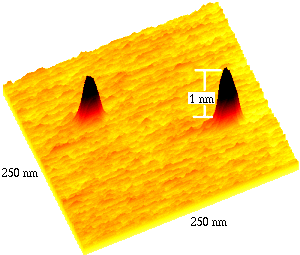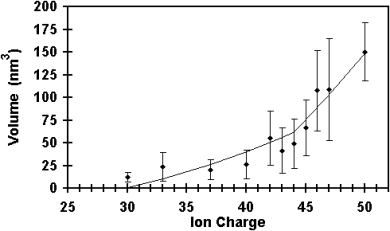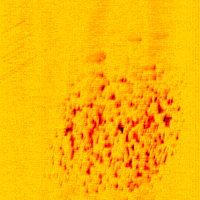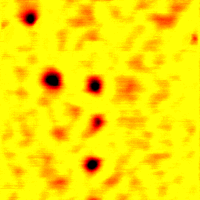Ion-Surface Interactions
A highly charged ion (considered here to have q>30) carries a large potential energy (tens to hundreds of keV); when it interacts with a surface, the release of that potential energy results in novel effects. Although the process of singly charged ions impacting a surface is well understood, when the ions are highly charged and slow, the physics changes dramatically and relatively little work has been done in this regime. As the highly charged ion approaches the surface, it becomes neutralized by the removal of electrons from the surface. Many of these electrons become bound in high lying states of the ion, creating a "hollow atom" with empty core states. The decay of this hollow atom occurs both above and below the surface by processes such as Auger and radiative decay. Upon impact of the projectile on the surface, the electrons still in high-lying states are "peeled off" and new electrons are supplied to neutralize the projectile. The projectile's excited electronic states soon decay via close collisions with target atoms.
In the particular case of slow, highly charged ions impacting insulating surfaces, it is hypothesized that the removal of electrons from a small region of the surface might cause that region to "Coulomb explode" [13,17], expelling ions and creating a shock wave which expels neutral atoms. This would make a small crater on the surface. Such topological changes to insulating surfaces are studied using atomic force microscopy. In addition, the spectroscopy of secondary particles such as x-rays, electrons and ions emitted during the bombardment are useful in understanding the physical processes by which the ion's substantial potential energy is transferred to the solid.
We have built a beam line [12,20] which delivers, for example, the highest flux of slow Xe44+ ions from any similar type of source. In addition to highly charged noble gas ions that we make from gas injected into the vacuum, we can make highly charged metal ions from low charge state metal ions injected from a MEVVA ion source located just above the EBIT. The ions are extracted from the EBIT into a continuous beam or a pulsed beam at about 8 keV/q and accelerated or decelerated just before they reach the target.
Several groups have observed that the ion impacts leave bumps on mica that are about 1 nm high and 15 nm across (as seen in the figure below left). The convex, rather than concave, nature of these features might be related to the highly anisotropic layered structure of mica. The CryEBIS group at Kansas State University has shown that the size of these bumps has very little correlation with the ion's kinetic energy [D.C. Parks et al. J. Vac. Sci. Technol. B 13, 941 (1995)]. In collaboration with that group, we have extended that work to show that the size has a strong correlation with ion potential energy [21], which is related non-linearly to ion charge (see figure below right).



We have bombarded l-valine (an amino acid) and seen the first evidence of craters formed by the ion impacts without further processing (i.e., etching or developing) as seen in the figure at right (the full width of the image is 2 µm). Although we have not yet determined that each crater seen is a result of a single impact, we see a definite contrast between the areas that were exposed to ions and those covered by a mask.

Another material that we have studied is PMMA, a high resolution resist used for microlithography. When we bombard PMMA covered silicon and subsequently etch the PMMA, we see PMMA craters that are ~25 nm across and correspond to single ion impacts as seen in the image on the left.
We have also bombarded self-assembled monolayers (SAMs) of dodecanethiolate on gold coated silicon (there is a thin layer of titanium used to adhere the gold to the silicon). After the exposure, we etched them in an ferricyanide solution which removes the gold that is no longer protected by the SAM molecules. By comparing the reflectivities of etched samples that had been exposed with highly charged ions to etched samples that had been exposed with metastable atoms, we found that the ions are 20 times more efficient at converting their potential energy to surface modifications than are the atoms.
As a demonstration of lithography with highly charged ions, we exposed both SAM and PMMA samples through masks. In both cases, the resolution is limited by the quality of the masks.
We have used x-ray spectroscopy to study the processes by which an Ar17+ ion decays as it approaches a silicon dioxide surface [16]. We found that the spectrum in the range 1 keV to 5 keV changes significantly with projectile speed. That is, at the lower velocities, a peak that is characteristic of silicon K decay appeared. It is due to a two atom Auger process whereby the projectile K-shell vacancy is filled by a K-shell electron from a silicon target atom and that vacancy decays with the release of an x-ray photon.
decay appeared. It is due to a two atom Auger process whereby the projectile K-shell vacancy is filled by a K-shell electron from a silicon target atom and that vacancy decays with the release of an x-ray photon.
The LLNL EBIT group has extensively studied the secondary ions from highly charged ion bombardment [D.H.G. Schneider and M.A. Briere, Physica Scripta 53, 228 (1996)], a process known as SIMS or Secondary Ion Mass Spectrometry. SIMS is a common technique for studying surfaces which, at high lateral resolution, is limited by the small fraction of the removed material that is ionized. That is, the ion beams commonly used (for example, Ga+) might remove all of the material in the small area meant to be studied before enough ions have been emitted to produce an adequate spectrum. The expectation is that the highly charged ion will preferentially remove material in ion form, increasing the SIMS signal. Preliminary results have already shown a large increase in secondary ion yield (per incident ion).
In connection with International SEMATECH, we are studying the effect of highly charged ions on the degradation of surfaces that are of interest for extreme ultraviolet lithography.

